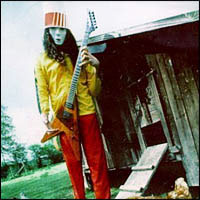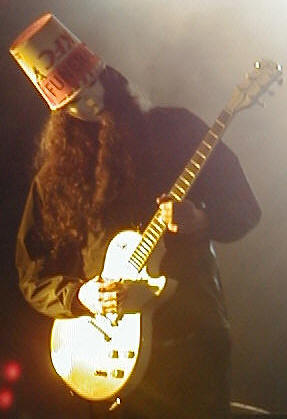| Axl Rose |
| Buckethead |
| Robin Finck |
| Richard Fortus |
| Tommy Stinson |
| Dizzy Reed |
| Chris Pittman |
| Brain "Brain" Mantia |
| Back to Main Page |
|
Buckethead Lead Guitar |
 The
Buckethead backstory begins with a kid named Brian Carroll growing up in a
Southern California suburb not far from Disneyland. He's a shy kid and
spends a lot of time in his room, which is filled with comic books, video
games, martial-arts
movie memorabilia, slasher-flick stuff, all the usual youth-culture
detritus. He also spends a whole lot of time at Disneyland.
The
Buckethead backstory begins with a kid named Brian Carroll growing up in a
Southern California suburb not far from Disneyland. He's a shy kid and
spends a lot of time in his room, which is filled with comic books, video
games, martial-arts
movie memorabilia, slasher-flick stuff, all the usual youth-culture
detritus. He also spends a whole lot of time at Disneyland.
As a teenager, Brian takes up the guitar, plonking away under the sway of
such metal masters as Angus Young of AC/DC; the late Randy Rhoads, of the
Ozzy Osbourne band; and Swedish overdrive virtuoso Yngwie Malmsteen. Like
the latter two, Carroll incorporates a considerable amount of
classical-music consciousness into his burgeoning style. He reads a lot of
music theory. He starts getting really, really good.
Unlike his idols, however, Carroll is anything but flamboyant. Mane-tossing
guitar-god moves are not something he'll ever be comfortable attempting. In
fact, in an ideal world, there'd be somebody else he could one day take up
onstage with him and hide behind. Some sort of alter ego.
Nobody much liked the 1988 fright flick "Halloween 4: The Return of Michael
Myers." After 10 years, this slasher franchise was pretty much played out.
(Even though it's still with us today!) But Brian Carroll was inspired by
the film. He went right out after seeing it and bought a Michael Myers-like
white mask. Then, that night, as he was eating from a bucketful of take-out
fried chicken, another inspiration struck. He described it in a 1996
interview with Guitar Player magazine: "I was eating it, and I put
the mask on and then the bucket on my head. I went to the mirror. I just
said, 'Buckethead. That's Buckethead right there.' It was just one of those
things. After that, I wanted to be that thing all the time."
Unlike the editors of Guitar Player (for which Bucket once wrote a
column called "Psychobuddy"), you needn't be conversant with minor 9th
intervals or quadratonal arpeggios to be knocked sideways by Buckethead's
war-of-the-worlds guitar eruptions. His star-burst chord clusters and
eye-frazzling eight-finger solos aren't like much else you'll be hearing on
this planet anytime soon.
Of course there are all kinds of aspiring guitar wizards out there (although
probably none within pick-flicking distance of this guy). But what sets
Carroll decisively apart from the pack is the outré "Buckethead" persona
he's so painstakingly created. This character, with its vaguely sinister
mask, soberly upended KFC bucket, and absurdly detailed chicken fetish, is
pure American surrealism. Buckethead is a star of a strange new kind: not
the projection of a preening personality, as is usually the case, but a
mirror, a screen, a somehow lovable cipher. As a musical presence, he seems
almost (one of Carroll's favorite words) disembodied.
Although most people are probably experiencing Buckethead for the first time
in his current stint with the new Guns N' Roses, the man has been putting
out solo albums for the last 10 years. Some, like the 1999 Monsters and
Robots, are pure "post-metal psycho-shred," as one writer put it.
Others, like the just-released Electric Tears, are serenely ambient.
Buckethead also records under the name Death Cube K (an anagram); the 1994
Dreamatorium is a good one.
In addition to this solo output, Buckethead has also recorded and performed
with a wild array of other musicians, from P-Funk all-stars Bootsy Collins
and Bernie Worrell to Iggy Pop, Primus, avant-fusion bassist Bill Laswell
and the late Miles Davis Quintet drummer Tony Williams. He's played on three
albums by "The Lord of the Rings" star Viggo Mortensen, one by the painter
Julian Schnabel, and some movie soundtracks and scores, too ("The Last
Action Hero," "Mortal Kombat," "Beverly Hills Ninja"). He longs to do an
all-Disney album. ("When You Wish Upon a Star" is one of his favorite
tunes.) (source:Written by Kurt Loder ,MTV.com)
Musical
Stylings:An accomplished multi-instrumentalist best
known for his virtuosic command of the electric guitar, Buckethead is one of
the instrument's most recognizable contemporary
innovators, his rapid-fire riffing, near-robotic fretwork, and idiosyncratic
lead lines combining elements of Yngwie Malmsteen, Adrian Belew, Slayer's Kerry King,
P-Funk's Eddie Hazel, and avant-improv artist John Zorn's
Scud-attack sax abuse.
Previous
bands: Apart f rom solo guitar albums under his own name and the name of Death Cube K(an anagram for Buckethead) his collabarations and bands include
Deli Creeps, Henry Kaiser, Bill Laswell, Bootsy Collins, Bernie Worrell,
Praxis, Jonas Hellborg, Michael Shrieve, MCM and the Monster, Tony Williams (w/ Arcana), Giant Robot, Giant Robot 2, Primus, Zillatron, Painkiller, John
Zorn, Company Week '91, Anton Fier, Julian Schnabel, Insvisibl Skratch Piklz,
Michael Kamen, George S. Clinton, Pieces (Buckethead and Brain), Cobra
Strike, Viggo Mortensen, El Stew, Ben Wa, Mike Keneally, Iggy Pop, Banyan, phonosychographDISK, DJ QBERT, William Ackerman, Jon Hassell and Bluescreen
rom solo guitar albums under his own name and the name of Death Cube K(an anagram for Buckethead) his collabarations and bands include
Deli Creeps, Henry Kaiser, Bill Laswell, Bootsy Collins, Bernie Worrell,
Praxis, Jonas Hellborg, Michael Shrieve, MCM and the Monster, Tony Williams (w/ Arcana), Giant Robot, Giant Robot 2, Primus, Zillatron, Painkiller, John
Zorn, Company Week '91, Anton Fier, Julian Schnabel, Insvisibl Skratch Piklz,
Michael Kamen, George S. Clinton, Pieces (Buckethead and Brain), Cobra
Strike, Viggo Mortensen, El Stew, Ben Wa, Mike Keneally, Iggy Pop, Banyan, phonosychographDISK, DJ QBERT, William Ackerman, Jon Hassell and Bluescreen
Influences: Michael Jackson, Paul Gilbert, Shawn Lane, Yngwie Malmsteen, Bootsy Collins and Angus Young (AC/DC) as major inspirations as well as the experience of playing with Bill Laswell, Bernie Worrell, John Zorn, the Invisibl Skratch Picklz and other artists he has played and collaborated with. He also finds inspiration in books, sci-fi/horror movies and athletes, most notably Michael Jordan.
Equipments:Guitars: Jackson Flying V, Steinberger GS, ESP MII, Gibson Chet Atkins, Ibanez X-Series Flying V, Takamine Acoustic, '59 Les Paul Custom (used on some Laswell-related projects), Gibson SG. '69 Gibson Les Paul Custom (used on the Cobra Strike and Viggo Mortensen projects recorded at Travis Dickerson Recording Studio).
Amplifiers: Peavey Reknown, misc. Marshall & Mesa Boogie heads, a Matt Wells head, Harry Kolbe Cabinets.
Effects: Roland SE 50, Rocktron Intellifex, Rockman, a Zoom multi effects unit, Alesis Midiverb II, A wah wah, Lexicon JamMan, Electro Harmonix Micro Synthesizer, Pro Co Rat, Digitech Whammy Pedal, Misc Toys.
Links:
Official site
www.bucketheadland.com